A Short History of the "Kettering Group"
The
text below was published in the book "Cytringainian Farewell, Kettering
Grammar/Boys School (1577-1993)". It is Geoff Perry's account the satellite
tracking work done at the Kettering Grammar/Boys School. The text is unedited. I
have only added a few pictures.Anyone printing a large extract of Geoff Perry's
text must obtain the permission of the editor of the book Rex Moore. Try to
contact him via this address:
The Old Cytringanians, c/o Kettering Old Grammar School
Foundation, 4 The Business Exchange, Rockingham Road, Kettering NN16 8JX,
UK.
Sven Grahn
The extra-curricular satellite research studies
© Geoffrey E Perry MBE CPhys FInstP
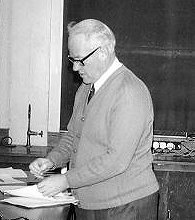 I am frequently asked, "How did you get started with the satellite
work?" There were several milestones which I will list chronologically. In
1944, a V-2 fell a few miles from my home in Braintree with a double bang. At
the time we did not know what it was but as soon as it was revealed to
have been a rocket I realised that `space travel' was no longer a wild
dream. Then my late cousin gave me, for Christmas 1951, a copy of Arthur
C Clarke's The Exploration of
Space setting out the principles based
on fundamental physics. Thirdly, I anticipated that the Oxbridge Scholarship
papers would include a question/essay on the International Geophysical
Year and so I read up the topic which included plans for the USA and the
USSR to launch small satellites. As it happened, there was nothing in the
exams about the IGY but when Sputnik 1 was launched on 4 October 1957 I
was mentally prepared for it. Russell Gladden, the senior science master,
made several visual observations of its rocket, getting up before dawn
to do so. I did not get up to see it but I did see and photograph Sputnik
2, which carried the dog, Laika, into orbit one month later. John Osborne,
of Stowe School, played a recording of the signals from Sputnik 1 at the
Annual Meeting of the Science Masters' Association in Leeds during the
Christmas vacation of 1957. The whole-octave Doppler shift in pitch was
remarkable and he promised me a copy for use as a teaching aid - it never
came.
I am frequently asked, "How did you get started with the satellite
work?" There were several milestones which I will list chronologically. In
1944, a V-2 fell a few miles from my home in Braintree with a double bang. At
the time we did not know what it was but as soon as it was revealed to
have been a rocket I realised that `space travel' was no longer a wild
dream. Then my late cousin gave me, for Christmas 1951, a copy of Arthur
C Clarke's The Exploration of
Space setting out the principles based
on fundamental physics. Thirdly, I anticipated that the Oxbridge Scholarship
papers would include a question/essay on the International Geophysical
Year and so I read up the topic which included plans for the USA and the
USSR to launch small satellites. As it happened, there was nothing in the
exams about the IGY but when Sputnik 1 was launched on 4 October 1957 I
was mentally prepared for it. Russell Gladden, the senior science master,
made several visual observations of its rocket, getting up before dawn
to do so. I did not get up to see it but I did see and photograph Sputnik
2, which carried the dog, Laika, into orbit one month later. John Osborne,
of Stowe School, played a recording of the signals from Sputnik 1 at the
Annual Meeting of the Science Masters' Association in Leeds during the
Christmas vacation of 1957. The whole-octave Doppler shift in pitch was
remarkable and he promised me a copy for use as a teaching aid - it never
came.
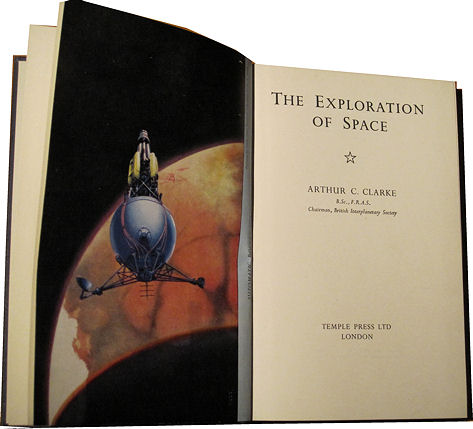
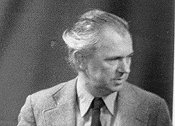 When
radio amateur G3FOZ, Derek Slater, was appointed to the staff as senior
chemistry master, following the untimely death of Fred Lawson, I realised
that here was somebody with the means to let me listen to the satellites
that I had been observing visually and photographically for the past two
years. Without Derek's expertise, equipment and co-operation this account
would never have come to be written - but I will leave him to give his
own version.
When
radio amateur G3FOZ, Derek Slater, was appointed to the staff as senior
chemistry master, following the untimely death of Fred Lawson, I realised
that here was somebody with the means to let me listen to the satellites
that I had been observing visually and photographically for the past two
years. Without Derek's expertise, equipment and co-operation this account
would never have come to be written - but I will leave him to give his
own version.
We achieved success at our first attempt
to receive
signals from the newly
launched Sputnik 4
, very early one Monday morning
in May 1960. Tape recordings were made throughout the week and then a borrowed
signal generator was returned to Cyril Dobson and Derek's CR-100 reverted to use
by his Radio Club. I had my Doppler recording, and that was that. Actually, we
missed the opportunity to share in a world news scoop. On the Friday, signals
were received later than expected. When asked why, I responded that the
satellite must have moved higher. It had - unintentionally! The Russians had
tried to recover a spherical capsule containing a dummy cosmonaut but the
spaceship had been pointing in the wrong direction when the rocket motor
fired.
At a course for physics teachers,
held at University College, London, in the summer of 1961, I learnt that
the Radio & Space Research Station at Slough supplied predictions to
amateur observers and I applied to be added to their mailing list. Until
then I had relied on predictions printed in the Daily Telegraph.
Predictions during the autumn half term holiday indicated that the American
Discoverer 32 was transmitting in the short-wave band and so the apparatus
was reassembled and observations were made until it decayed. These were
forwarded to Slough and were said to be `useful'. It was suggested that
we might monitor Discoverer 36 and we decided to wait until the Christmas
holiday when it would be nearer to decay. Unfortunately its batteries failed
after we had monitored it for a few weeks but, by adding our Discoverer
32 decay curve to the observations, I was able to predict the decay date
with some accuracy.
The USSR inaugurated its
Cosmos series of satellites in April 1962 and this has provided me with
a source of objects to monitor to this day (as of 6 July 1994 we have now
reached Cosmos 2282). Concentration on a sub-set of Cosmos satellites which
disappeared from orbit after flights lasting only eight days or less -
long before they would have decayed naturally - was the key to unlocking
many of the secrets of the Soviet military space programme carried out
under the Cosmos label.
In that summer term two officers
at RAF Henlow wrote to ask if they might visit the School. Wishing to establish
a satellite monitoring project for their cadets, they had been to the Minitrack
station at Winkfield. On expressing their dismay at the amount of expensive
apparatus in use there they had been told, "Why don't you see the folks
at Kettering Grammar School? They are doing useful work with `backyard
equipment'." It was important to choose a satellite which would permit
a `live' demonstration. The Russian Cosmos 5 filled the bill but, as soon
as I heard it, it was obvious that its signals were of an unusual character.
A periodic variation in pitch was superimposed on the normal Doppler shift.
After his A-levels, Robert Jones made a study of the variation which indicated
that it was due to a partly faulty solar battery.
During a trip to Wales in
the autumn half-term holiday I called at the physics department at Aberystwyth,
having read that they had also made observations of Cosmos 5. Ken Edwards,
the chief technician, had a large collection of pen-recordings of the signals
which showed that they ceased completely when the satellite was in the
Earth's shadow, confirming our hypothesis.
The development of our computational
capability over the years has been quite extraordinary. Initially we employed
slide rules and graphical techniques. In 1964 through the friendship of
Ron Smith, we used Autocode with the Elliott 803 computer at the CWS corset
factory at Desborough to analyse pupils' visual observations of the Echo
2 balloon satellite, moving on, with Ron, to Algol programming on SATRA's
4120. I purchased a hand-cranked mechanical calculator before electronic
pocket calculators came on the scene and, in 1972, I was given a 30-step
programmable desk-top calculator by the US Ambassador, Walter Annenberg.
Within a week of taking delivery it had been used to identify a constellation
of Soviet navsats. Brief use of the ICL 1900 at County Hall, necessitating
trips to the Technical College in St Mary's Road to prepare the data, ended
with the arrival of the Commodore 4032 which brought computing with programming
in Basic into the laboratory. Today, members of the Group all have their
own PCs with DOS or Windows. My daughter, remembering the excitement of
the early days, dismisses the modern technological map displays and prediction
print-outs with, "I don't call that tracking!"
When Cosmos 112 was launched
on 17 March 1966, it quickly became apparent that there was something very
different about it besides its departure from the standard 65° inclination
to the Equator. Signal duration was shorter and it was being controlled
from a more northerly station than usual. Examination of its initial ground
track revealed that it could not have been launched from Baikonur. I wrote
a letter to the editor of FLIGHT International claiming that the
USSR was using a new launch site but it produced little or no reaction.
There were more launches at similar inclinations but it was not possible
to locate the origin precisely. When Cosmos 129 was launched in October
1966 I phoned my data to Ron Smith at SATRA. When I collected the output
I saw that my orbit-count differed from US data, being three too many.
This, together with the inclination of 64.6° instead of 65° led
me to realise that Cosmos 129 had also been launched from the new site.
The intersection of its initial ground track with that of Cosmos 112 lay
some 200 miles south of Archangelsk. I announced the co-ordinates of the
site at a meeting of the British Interplanetary Society in London and followed
it up with a second letter to FLIGHT. Once again there was no initial
reaction but the late Dr Charles S Sheldon II, of the Congressional Research
Service of the US Library of Congress, wished to include details of the
site in a report. His manuscript had been returned by the CIA with that
section marked `Classified'. His reaction was to alert the press to what
I had written in FLIGHT and on the day after we broke up for the
Christmas holiday, The Times ran the story under the by-line `From
our Washington correspondent'. My life changed from that point.
It rained on the morning of the Friday of
the 1967 autumn half-term holiday. It started when I was on the fourth tee of
Corby's municipal golf course and I got soaked to the skin. I went to the Labs
in the afternoon and switched on the CR-100. It was not long before I heard a
short burst of irregular pulses
(hear signals from Cosmos 186 recorded the day efter in Stockholm,
Sweden)
. I ran the tape recorder and recorded
further 30-second bursts at two minute intervals. In 1966 Ken Edwards had sent a
pen record of some strange signals for me to identify. They, too, consisted of
30-second bursts of irregular pulses at two minute intervals and proved to have
been from Cosmos 140, a precursor of the ill-fated Soyuz 1. My signals were from
the first test of a Soyuz since Komarov's tragic
death.
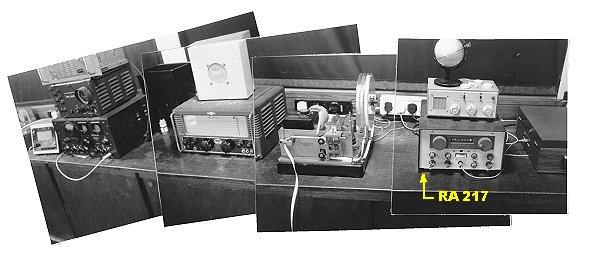
Click
on the picture to see another version
On the following day I had
a phone call from Peter Fairley, of the London Evening Standard,
who was off to Cape Canaveral for the first launch of a Saturn V. As the
fiftieth anniversary of the Russian revolution was imminent he wondered
if anything of interest had happened. I said, "No - apart from an unmanned
test of a Soyuz." The Soviet Union had yet to announce the launch and he
broke the story with the banner headline, `Schoolboys Tune In To A Space
Secret', in the midday edition. Two world scoops within twelve months!
Clearly this was no accident. Old Cytringanian, Robin Turner, of the Daily
Express, happened to be in Kettering for his brother's wedding and
found me at the Labs on the Sunday, listening to the signals. The CR-100
was becoming temperamental, needing a smart tap with the hand from time
to time, and Robin remarked that I `could do with something better'. I
told him that I knew of a second-hand RA17 which could be had for the cost
of refurbishment - I had already applied unsuccessfully for a grant to
purchase it. Next day he phoned my wife and told her that he had persuaded
his editor to `go halves' with Racal and give me a new receiver. I was
lecturing to the BIS at the City University on the Tuesday evening. Before
the lecture I was presented with a brand new, state of the art, transistorised
RA217 by the chairman of Racal, (now Sir) Ernest Harrison and John Young,
assistant to the editor of the Daily Express. Their gift removed
all the uncertainty whilst retaining all of the pleasure.
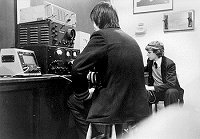 I
am also often asked how the Kettering Group came into being. Like Topsy,
in Uncle Tom's Cabin - it just grew. The first pupil to be entrusted
with the key to the Labs in order to make an observation was my nextdoor
neighbour from Southgate Drive, David Sinnett, who helped me occasionally
at weekends. The first pupils to make regular observations were the sixth
form girls from Kettering High School who came to us for physics, chemistry
and mathematics and who sat in the empty Physics A during some of their
free periods as there was nowhere else for them to go. One day, as I went
off to teach in another room, I said to them, "If that thing starts to
bleep, note the time for me on the blackboard." That was the real start
of pupil involvement. It soon paid dividends. FLIGHT reported that
Cosmos 32 had decayed on 18 June 1964 at 1200 ± 12 hours - no better
than saying that it had come down on Thursday! Barbara Jacques and Derek
had logged it at 1129 BST that day and so I wrote a letter to the editor
of
FLIGHT narrowing down the time, signing it `Barbara M Jacques,
G E Perry & J D Slater'. A letter came back addressed to Miss Jacques
and her pupils. After we had clarified the position, Ken Owen from FLIGHT
visited the School and published a two-page article, `Kettering's Cosmos
Scholars', in their space special issue of 22 July 1965. That was the first
international media exposure that we received.
I
am also often asked how the Kettering Group came into being. Like Topsy,
in Uncle Tom's Cabin - it just grew. The first pupil to be entrusted
with the key to the Labs in order to make an observation was my nextdoor
neighbour from Southgate Drive, David Sinnett, who helped me occasionally
at weekends. The first pupils to make regular observations were the sixth
form girls from Kettering High School who came to us for physics, chemistry
and mathematics and who sat in the empty Physics A during some of their
free periods as there was nowhere else for them to go. One day, as I went
off to teach in another room, I said to them, "If that thing starts to
bleep, note the time for me on the blackboard." That was the real start
of pupil involvement. It soon paid dividends. FLIGHT reported that
Cosmos 32 had decayed on 18 June 1964 at 1200 ± 12 hours - no better
than saying that it had come down on Thursday! Barbara Jacques and Derek
had logged it at 1129 BST that day and so I wrote a letter to the editor
of
FLIGHT narrowing down the time, signing it `Barbara M Jacques,
G E Perry & J D Slater'. A letter came back addressed to Miss Jacques
and her pupils. After we had clarified the position, Ken Owen from FLIGHT
visited the School and published a two-page article, `Kettering's Cosmos
Scholars', in their space special issue of 22 July 1965. That was the first
international media exposure that we received.
In 1974 I began receiving
regularly by airmail two line orbital element sets for all objects currently
in orbit. These are produced in NORAD's Cheyenne Mountain complex by US
Space Command and are distributed to bona fide researchers by NASA's
Goddard Space Flight Center near Washington DC. The elsets enable one to
compute a satellite's position, velocity and acceleration at a particular
instant and to predict its subsequent motion. Although we were receiving
signals from only a few satellites, I realised that these elsets were a
valuable source of data from which deductions could be made about the purpose
of various classes of Soviet satellites which we could not monitor. Individual
pupils were allocated different sub-sets of satellites and by collecting
the elsets, analysing plane-spacings, orbital periods, etc., they were
able to infer the operational status of communications, navigation, missile
early warning and electronic intelligence gathering constellations. The
results were published from time to time, jointly in their and my names,
in the technical press and US Senate and Congressional Reports.
In January 1966, a Swedish student sent
me a tape recording of signals which he believed to be from Cosmos 104, asking
me for confirmation. Our association has continued to this day and Sven Grahn,
the first overseas member of the Kettering Group, is now the General Manager,
Science Systems Division, of the Swedish Space Corporation and has been
responsible for their Viking and Freja satellites. Other
adults in the UK and
abroad , with interests, have worked closely with us
over the years. They are professional people with expertise in electronic
engineering, communications, meteorology, photographic interpretation, etc., but
all share the excitement of participation in a hobby of amateur observation and
analysis of space programmes, many of which are still considered to be
secret.
 As
the number of adults from the UK and overseas, associated with the Group
increased and the assured change of the School's name upon disorganisation
along comprehensive lines loomed larger, I decided to drop the words `Grammar
School' from the name and since the mid-'seventies published observations
and results under the title of The Kettering Group. At my suggestion, John
Marshall produced the logo of a satellite in orbit around the rose from
the Grammar School blazer badge. The centre of the rose was at the focus
of the orbit since the Group was frequently the focus of media attention
and the orbit was elliptical to support the popular belief that I am eccentric!
As
the number of adults from the UK and overseas, associated with the Group
increased and the assured change of the School's name upon disorganisation
along comprehensive lines loomed larger, I decided to drop the words `Grammar
School' from the name and since the mid-'seventies published observations
and results under the title of The Kettering Group. At my suggestion, John
Marshall produced the logo of a satellite in orbit around the rose from
the Grammar School blazer badge. The centre of the rose was at the focus
of the orbit since the Group was frequently the focus of media attention
and the orbit was elliptical to support the popular belief that I am eccentric!
I never claimed that no one
else knew about the USSR's northern launch site - only that I was the first
to publicly disclose its use and reveal its approximate location. Somebody
looked up the co-ordinates and gave it the name Plesetsk. The USSR did
not acknowledge its existence until more than 17 years later, in 1983 Pravda
articles by V Gubarev. Charles Sheldon called at the School in October
1967 when he was motoring around the UK with his wife. A friendship and
co-operation developed which lasted until he died in 1981. He quoted my work
in Soviet Space Programs, 1971-75.
Hence, with the passage
of time, these Kettering techniques have given a highly professional, consistently
positive identification to many aspects of the Soviet space program from
completely unclassified, private sources, which are not matched by any
public release of data by the Soviet, United States, or British governments.
The general public interested in data on Soviet flights owes a debt to
the Kettering Grammar School whose published findings in a few instances
may have been factors toward influencing the official bureaucracies to
ease up on the rigid suppression of what is essentially non-sensitive information
about space flights.
He invited me to contribute
to the 1971-75 study and to collaborate with him on the 1976-1980 study.
After he died, the Library asked me to complete the work in collaboration
with Marcia Smith, one of his specialists, who is continuing his work.
I count Marcia as a Kettering Group member and we worked together on the
1981-87 study.
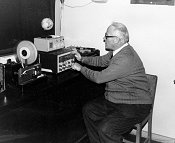 I
was appointed an Ordinary Member of the Order of the British Empire in
the 1973 New Year Honours List for "founding and leading the Satellite
Tracking Group, Kettering Grammar School". In 1974 I received the Royal
Astronomical Society's Jackson-Gwilt Medal and Gift - the £50 was
spent on an antenna and pre-amplifier. The Universities of Loughborough,
Reading and Leicester and the Open University conferred Honorary Masters
Degrees on me and I have accepted all of these with the realisation that
it was the work of the Group that was being recognised. The Kettering Group
was awarded the Royal Aero Club's Prince of Wales Cup for team effort during
1983 and a large number of members, including three from the USA and Sven
from Sweden, attended the presentation at the Science Museum in December
1984. A personal honour which gave me great pleasure was one of the first
Institute of Physics Teachers of Physics Awards in 1986 and I was very
pleased to see that John Marshall, now at Beaconsfield High School, received
one of those awards this year.
I
was appointed an Ordinary Member of the Order of the British Empire in
the 1973 New Year Honours List for "founding and leading the Satellite
Tracking Group, Kettering Grammar School". In 1974 I received the Royal
Astronomical Society's Jackson-Gwilt Medal and Gift - the £50 was
spent on an antenna and pre-amplifier. The Universities of Loughborough,
Reading and Leicester and the Open University conferred Honorary Masters
Degrees on me and I have accepted all of these with the realisation that
it was the work of the Group that was being recognised. The Kettering Group
was awarded the Royal Aero Club's Prince of Wales Cup for team effort during
1983 and a large number of members, including three from the USA and Sven
from Sweden, attended the presentation at the Science Museum in December
1984. A personal honour which gave me great pleasure was one of the first
Institute of Physics Teachers of Physics Awards in 1986 and I was very
pleased to see that John Marshall, now at Beaconsfield High School, received
one of those awards this year.
Relations with the media
have blossomed over the years becoming a far cry from the days when I had
to seek permission from J K "when you've heard one, you've heard them all"
Dudley to give a story to the Evening Telegraph. As our work became
more well-known and valued I adopted the policy of notifying Reuters of
our `discoveries' and then waiting for the press and TV to contact me.
The link with Peter Fairley continued when he moved to ITN and I was a
member of their Studio Panel in 1971 for Apollo 15. In 1975, Frank Miles,
then science editor at ITN, persuaded (now Sir) David Nicholas to invest
his budget in using our Group for their coverage of the Apollo-Soyuz mission
when American and Russians linked in space with Frank's `handshake over
Bognor' - but that is another long story. The radio at the School, with
Derek and the boys, was linked by direct line to the pen-recorder with
me in the studio in London. When I retired from teaching in 1984, David
asked me to work exclusively for ITN and our agreement has been regularly
renewed. Although it is increasingly difficult to get space stories on
news bulletins, I am still ITN's space consultant. Furthermore, the work
of the Group continues - only the pupil segment no longer exists.
Postscript by Sven Grahn:
Here is a clip from an 8-mm movie that I made
during a visit to Kettering in August 1967.

 Back
to "Space Tracking Notes"
Back
to "Space Tracking Notes"
 I am frequently asked, "How did you get started with the satellite
work?" There were several milestones which I will list chronologically. In
1944, a V-2 fell a few miles from my home in Braintree with a double bang. At
the time we did not know what it was but as soon as it was revealed to
have been a rocket I realised that `space travel' was no longer a wild
dream. Then my late cousin gave me, for Christmas 1951, a copy of Arthur
C Clarke's The Exploration of
Space setting out the principles based
on fundamental physics. Thirdly, I anticipated that the Oxbridge Scholarship
papers would include a question/essay on the International Geophysical
Year and so I read up the topic which included plans for the USA and the
USSR to launch small satellites. As it happened, there was nothing in the
exams about the IGY but when Sputnik 1 was launched on 4 October 1957 I
was mentally prepared for it. Russell Gladden, the senior science master,
made several visual observations of its rocket, getting up before dawn
to do so. I did not get up to see it but I did see and photograph Sputnik
2, which carried the dog, Laika, into orbit one month later. John Osborne,
of Stowe School, played a recording of the signals from Sputnik 1 at the
Annual Meeting of the Science Masters' Association in Leeds during the
Christmas vacation of 1957. The whole-octave Doppler shift in pitch was
remarkable and he promised me a copy for use as a teaching aid - it never
came.
I am frequently asked, "How did you get started with the satellite
work?" There were several milestones which I will list chronologically. In
1944, a V-2 fell a few miles from my home in Braintree with a double bang. At
the time we did not know what it was but as soon as it was revealed to
have been a rocket I realised that `space travel' was no longer a wild
dream. Then my late cousin gave me, for Christmas 1951, a copy of Arthur
C Clarke's The Exploration of
Space setting out the principles based
on fundamental physics. Thirdly, I anticipated that the Oxbridge Scholarship
papers would include a question/essay on the International Geophysical
Year and so I read up the topic which included plans for the USA and the
USSR to launch small satellites. As it happened, there was nothing in the
exams about the IGY but when Sputnik 1 was launched on 4 October 1957 I
was mentally prepared for it. Russell Gladden, the senior science master,
made several visual observations of its rocket, getting up before dawn
to do so. I did not get up to see it but I did see and photograph Sputnik
2, which carried the dog, Laika, into orbit one month later. John Osborne,
of Stowe School, played a recording of the signals from Sputnik 1 at the
Annual Meeting of the Science Masters' Association in Leeds during the
Christmas vacation of 1957. The whole-octave Doppler shift in pitch was
remarkable and he promised me a copy for use as a teaching aid - it never
came.

 When
radio amateur G3FOZ, Derek Slater, was appointed to the staff as senior
chemistry master, following the untimely death of Fred Lawson, I realised
that here was somebody with the means to let me listen to the satellites
that I had been observing visually and photographically for the past two
years. Without Derek's expertise, equipment and co-operation this account
would never have come to be written - but I will leave him to give his
own version.
When
radio amateur G3FOZ, Derek Slater, was appointed to the staff as senior
chemistry master, following the untimely death of Fred Lawson, I realised
that here was somebody with the means to let me listen to the satellites
that I had been observing visually and photographically for the past two
years. Without Derek's expertise, equipment and co-operation this account
would never have come to be written - but I will leave him to give his
own version.

 I
am also often asked how the Kettering Group came into being. Like Topsy,
in Uncle Tom's Cabin - it just grew. The first pupil to be entrusted
with the key to the Labs in order to make an observation was my nextdoor
neighbour from Southgate Drive, David Sinnett, who helped me occasionally
at weekends. The first pupils to make regular observations were the sixth
form girls from Kettering High School who came to us for physics, chemistry
and mathematics and who sat in the empty Physics A during some of their
free periods as there was nowhere else for them to go. One day, as I went
off to teach in another room, I said to them, "If that thing starts to
bleep, note the time for me on the blackboard." That was the real start
of pupil involvement. It soon paid dividends. FLIGHT reported that
Cosmos 32 had decayed on 18 June 1964 at 1200 ± 12 hours - no better
than saying that it had come down on Thursday! Barbara Jacques and Derek
had logged it at 1129 BST that day and so I wrote a letter to the editor
of
FLIGHT narrowing down the time, signing it `Barbara M Jacques,
G E Perry & J D Slater'. A letter came back addressed to Miss Jacques
and her pupils. After we had clarified the position, Ken Owen from FLIGHT
visited the School and published a two-page article, `Kettering's Cosmos
Scholars', in their space special issue of 22 July 1965. That was the first
international media exposure that we received.
I
am also often asked how the Kettering Group came into being. Like Topsy,
in Uncle Tom's Cabin - it just grew. The first pupil to be entrusted
with the key to the Labs in order to make an observation was my nextdoor
neighbour from Southgate Drive, David Sinnett, who helped me occasionally
at weekends. The first pupils to make regular observations were the sixth
form girls from Kettering High School who came to us for physics, chemistry
and mathematics and who sat in the empty Physics A during some of their
free periods as there was nowhere else for them to go. One day, as I went
off to teach in another room, I said to them, "If that thing starts to
bleep, note the time for me on the blackboard." That was the real start
of pupil involvement. It soon paid dividends. FLIGHT reported that
Cosmos 32 had decayed on 18 June 1964 at 1200 ± 12 hours - no better
than saying that it had come down on Thursday! Barbara Jacques and Derek
had logged it at 1129 BST that day and so I wrote a letter to the editor
of
FLIGHT narrowing down the time, signing it `Barbara M Jacques,
G E Perry & J D Slater'. A letter came back addressed to Miss Jacques
and her pupils. After we had clarified the position, Ken Owen from FLIGHT
visited the School and published a two-page article, `Kettering's Cosmos
Scholars', in their space special issue of 22 July 1965. That was the first
international media exposure that we received.
 As
the number of adults from the UK and overseas, associated with the Group
increased and the assured change of the School's name upon disorganisation
along comprehensive lines loomed larger, I decided to drop the words `Grammar
School' from the name and since the mid-'seventies published observations
and results under the title of The Kettering Group. At my suggestion, John
Marshall produced the logo of a satellite in orbit around the rose from
the Grammar School blazer badge. The centre of the rose was at the focus
of the orbit since the Group was frequently the focus of media attention
and the orbit was elliptical to support the popular belief that I am eccentric!
As
the number of adults from the UK and overseas, associated with the Group
increased and the assured change of the School's name upon disorganisation
along comprehensive lines loomed larger, I decided to drop the words `Grammar
School' from the name and since the mid-'seventies published observations
and results under the title of The Kettering Group. At my suggestion, John
Marshall produced the logo of a satellite in orbit around the rose from
the Grammar School blazer badge. The centre of the rose was at the focus
of the orbit since the Group was frequently the focus of media attention
and the orbit was elliptical to support the popular belief that I am eccentric!
